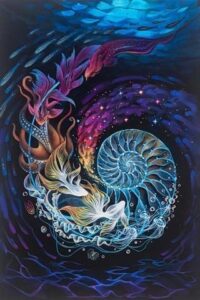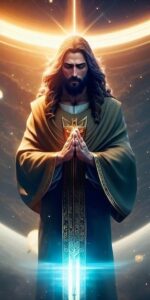THE MATRIX – REVELATION – Q – SOURCE CODES – NAG HAMMADI – GNOSIS
Q is a fictional character as well as the name of a race in Star Trek appearing in the Next Generation, Deep Space Nine, and Voyager series, as well as in related media. The most familiar Q is portrayed by John de Lancie. He is an extra-dimensional being of unknown origin who possesses immeasurable power over normal human notions of time, space, the laws of physics, and reality itself, being capable of violating or altering them in unpredictable ways with a hand gesture cue. Despite his vast knowledge and experience spanning untold eons (and much to the exasperation of the object(s) of his obsession), he is not above practical jokes for his own personal amusement, for a Machiavellian and manipulative purpose, or to prove a point. He is said to be nigh-omnipotent, and he is continually evasive regarding his true motivations.
The name “Q” applies to the names of the individuals portrayed (all “male” and “female” characters refer to each other as “Q”), it also applies to the name of their race and to the Q Continuum itself – an alternate dimension accessible to only the Q and their “invited” guests. The true nature of the realm is said to be beyond the comprehension of “lesser beings” such as humans, therefore it is shown to humans only in ways they can understand.
Beginning with the pilot episode “Encounter at Farpoint” of The Next Generation, Q became a recurring character, with pronounced comedic and dramatic chemistry with Jean-Luc Picard. He serves as a major antagonist throughout The Next Generation, playing a pivotal role in both the first and final episodes. Q is initially presented as a cosmic force judging humanity to see if it is becoming a threat to the universe, but as the series progresses, his role morphs more into one of a teacher to Picard and the human race generally – albeit often in seemingly destructive or disruptive ways, subject to his own amusement. Other times, notably during “Deja Q” and Voyager, Q appears to the crew seeking assistance.
Gene Roddenberry chose the letter “Q” in honor of his friend, Janet Quarton.
A reconstructed collection of sayings attributed to Jesus reveals Jesus as a Jewish sage who was later mythologized into the “Christ” revered by the world’s Christian communities
If its premise is accepted by a preponderance of theologians, this debatable study could bring about a rethinking of the origins of Christianity. Mack presents an analysis of the so-called Book of Q , a supposed collection of Jesus’s sayings that was compiled by his followers during his lifetime. Certain scholars, deducing the existence of the book, have reconstructed the putative text of this “lost gospel” during the last 20 years through a comparison of the gospels of Matthew and Luke, who, it is contended, used Q as a common basis (Q stands for Quelle , German for “source”). Mack, a professor of New Testament at the School of Theology at Claremont College in Los Angeles, concludes that “the people of Q”–Jesus’s contemporaries–thought of him as a teacher, not as a messiah, and that they did not regard his death as a divine or saving event. Mack offers an earthy, colloquial translation of the Book of Q with its wisdom sayings, exhortations, parables and apocalyptic pronouncements. His portrayal of the early Jesus movement reveals a community based on fictive kinship without regard to class, gender or ethnicity. The discovery of Q , Mack argues, compels us to see the New Testament gospels as imaginative creations rather than historical accounts
The Nag Hammadi Scriptures, edited by Marvin Meyer, is the most complete, up-to-date, one-volume, English-language edition of the renowned library of Gnostic manuscripts discovered in Egypt in 1945, which rivaled the Dead Sea Scrolls find in significance. It includes the Gospel of Thomas, the Gospel of Mary, and the recently discovered Gospel of Judas, as well as other Gnostic gospels and sacred texts. This volume also includes introductory essays, notes, tables, glossary, index, etc. to help the reader understand the context and contemporary significance of these texts which have shed new light on early Christianity and ancient thought. The compilation of ancient manuscripts that constitute The Nag Hammadi Scriptures is a discovery that challenges everything we thought we knew about the early Christian church, ancient Judaism, and Greco-Roman religions.







Just had a very funny vision which was very different to the beautiful experiences I usually share with Spirit. I saw Higher Beings all looking like aliens standing around some of us, shaking us gently and trying to wake us up and we were just laying there comatose. Made me laugh. Feels like Spirit shared a joke with me. They do have a sense of humour
Let’s take this for a pivotal remark: “Mack, a professor of New Testament at the School of Theology at Claremont College in Los Angeles, concludes that “the people of Q”–Jesus’s contemporaries–thought of him as a teacher, not as a messiah, and that they did not regard his death as a divine or saving event.”
THE PEOPLE OF Q – JESUS CONTEMPORARIES HAD NO IDEA, AND THEREFORE THIS MACK PROFESSOR OF NEW TESTAMENT THAT THE FOLLOWING SACRED WORDS ARE WRITTEN INDEED IN THE NEW TESTAMENT:
PHILIPPIANS 2:10-11 English Standard Version (ESV)
10 SO THAT AT THE NAME OF JESUS EVERY KNEE SHOULD BOW, IN HEAVEN AND ON EARTH AND UNDER THE EARTH, 11 AND EVERY TONGUE CONFESS THAT JESUS CHRIST IS LORD, TO THE GLORY OF GOD THE FATHER. AMEN! (…just for your records…and to the fragility of the human mind I guess…NOT MINE!)
Namaste Sandy,
Yes a good sense of humor is all through the universe. Joy and laughter are the greatest medicines. Much Love and Light…Paul